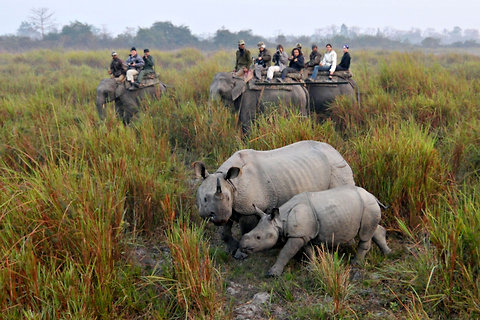Kaziranga, ASSAM — One challenge facing any visitor to one of India’s tiger parks is actually seeing a tiger. Often, people leave without ever catching a glimpse.
For many years, the same problem existed for visitors who came to see the rhinoceroses at the Kaziranga National Park in the northeastern state of Assam. At the low point a century ago, there were only a dozen rhinos in the entire park.
But now, when visitors roam the park by jeep or by elephant safari, they can see rhinos almost everywhere. Whether they are wandering through the high grasses, or cooling themselves in the park’s wetlands, rhinos are now resurgent at Kaziranga, in what has become India’s most successful conservation effort, if one tempered by growing concerns about renewed threats from poaching.
“It is a great conservation success story,” said Dipankar Ghose, a director at the World Wildlife Fund in India. “The local community also supports it in a big way. You do not see conflict killings in Kaziranga,” he said, referring to the killing of wild animals by nearby residents.
Last month, park rangers conducted a census inside Kaziranga that confirmed the positive trend. The final count was 2,329 rhinos, compared to 12 a century ago. This marks the latest improvement in a steady increase of the rhino population that has seen numbers rise from 366 in 1966 to 1,080 in 1984 to 2,048 in 1999 and steadily upward, according the
data maintained by the World Wildlife Fund.
Forest officials and conservation experts say the long-term increase in rhinos is because of better landscape management, better protection and the willing involvement of the local population in conservation efforts.
The “rhinoceros is the state animal of Assam, and people have a very deep-rooted affinity with them,” said Sanjib Kumar Bora, the forest conservator of Kaziranga National Park.
In addition, “maintaining the composite habitat of grassland and wetland with tree-covered areas in patches is the ideal habitat for the rhinoceros,” he said, which has been possible in Kaziranga because of community involvement and tough security measures.
Kaziranga encompasses an area of 430 square kilometers (166 square miles) in eastern Assam, with a contiguous area of roughly the same size that is also being slowly integrated into the park. About 500 guards patrol the entire large area, joined by 200 armed guards from the Assam Forest Protection Force, who enjoy special protection from prosecution while performing their duties inside the park. This provision is often interpreted as the authority to kill poachers inside the park.
Poaching, always a problem, has seen a new increase in recent years, as the price of rhino tusks has spiked upward, largely because of rising demand by consumers in China, who believe ground-up tusks can cure cancer and other ailments.
Poaching has intensified at game parks in Africa, where heavily armed gangs kill rhinos and saw off their horns to be sold for as much as $30,000 a pound. In Kaziranga, poachers killed 38 rhinos last year — far less than the 109 that died from natural causes but still a big increase from 2011, when only 13 rhinos died from poaching.
“Recently, we found that poachers were armed with AK-series rifles,” Mr. Bora said. “It is a matter of concern.”
The park administration has created 152 security posts to protect the rhinos and is giving sophisticated arms, like self-loading rifles and carbines, to security guards. This week, park officials tested unmanned aerial drones equipped with cameras, which will also be used to survey the park, The Associated Press reported.
Mr. Bora said that some of the poachers at Kaziranga have ties to local insurgent groups, who barter the horns for weapons at the Myanmar border. “One horn can fetch up to five million rupees,” or $92,000, he said. “People are attracted to the easy money.”
Kaziranga’s rangers are on heightened alert to insure that poaching does not escalate into the sort of threat proving so destructive in Africa. But for now, Kaziranga remains a conservation success story – and not only for rhinos but also tigers. The park has 106 tigers, with a healthy ratio of males to females, insuring that the numbers are likely to keep growing.
“As a forester, I am doubly proud,” Mr. Bora said. “My rhino population is increasing and tiger population is also increasing.”






Leave a reply